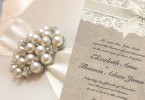Wedding cakes came about in Medieval times, as more of a ‘Wedding Bread’ crafted from wheat. They were seen as an emblem of fertility and were pitched at the woman.
The Romans toasted wheat and salt cakes to be dined on at a marriage. The groom would eat a part of the cake and the remaining would be broken over the brides head. Again this was a mark of fertility and success and very like the fight for the bouquet the participants would tug-of-war to acquire and snack at any spare crumbs as to get any remaining fortuity. Only the offspring of a married couple that had ‘broke bread’ at their wedding in this kind of way would qualify for high office and seriously acquire a life of prosperity.
Cake Cutting
The cutting ceremony is also steeped in history and symbolism. The cutting of the cake extends back to the Roman standing custom of crushing the cake upon the brides head and the war for the crumbs. As the wedding cake and congregation increased as time went on this became very hard so the bride would merely cut the cake and hand it out.
Why do they have layers?
As time passed wedding cakes got greater and way more innovative the concept of breaking them over the bride diminished. Brides that have been purchasing for wedding cakes and have seen the prospective size of them will be grateful for this.
The thought of a stacked cake can also be linked all the way back to Medieval times. In some places, their was a custom of stacking a ton of wedding cakes between the couple. The husband and wife then had to strive to kiss over the pile of cakes. Like lots of these customs, if they could accomplish it a life span of affluence was awaited. Through the passage of time, the stacks became tiered cakes.
Why are they white?
The reason why nearly all wedding cakes are white is pretty self-evident. White generally symbolizes purity and wedding cakes were typically called ‘bride’s cakes.’ A white wedding cake is supposed to represent the bride’s innocence.






